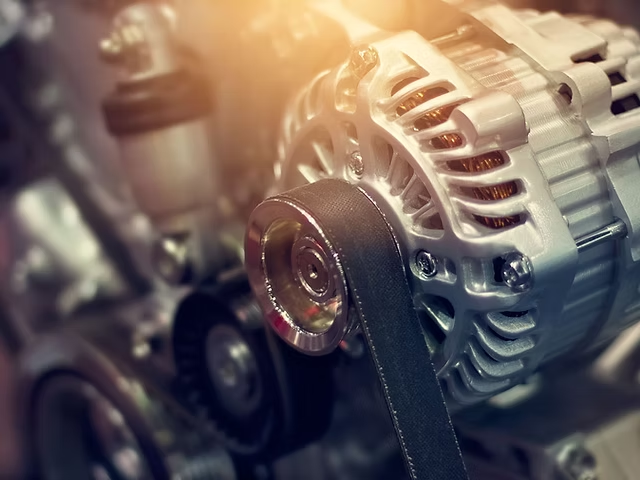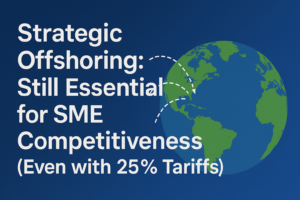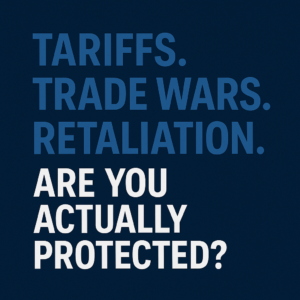
Optimizing Automotive Manufacturing: The Strategic Advantage of Third-Party DFM and Offshore Production
Executive Summary
In an increasingly competitive global market, automotive manufacturers are under intense pressure to reduce costs, improve quality, and maintain operational efficiency. Leveraging third-party Design for Manufacturing (DFM) specialty engineering coupled with fully managed offshore manufacturing in non-tariff regions such as India and Vietnam offers a transformative solution. This white paper details how refined product design—encompassing material science, design for logistics, and design for inspection—can lead to a substantial reduction in cost of goods sold (COGS), boost quality and reliability, and lower warranty costs. Furthermore, it presents an in-depth comparative analysis of labor rates and operational cost differences between North American manufacturing and offshore production, emphasizing the often-overlooked quality benefits inherent in Industry 4.0 factories in India and Vietnam.
By synthesizing insights from leading authorities such as McKinsey, Deloitte, and SAE International, and drawing on well-known automotive industry case studies, this paper articulates a comprehensive strategy for C-suite executives. It outlines how partnering with a DFM specialty engineering company and engaging in fully managed offshore manufacturing can drive financial, technological, and business benefits, ultimately positioning organizations for enhanced competitiveness and sustainability in the global market.
Introduction
The automotive industry is characterized by rapid innovation, evolving customer demands, and a relentless drive to reduce costs while maintaining high quality. As competition intensifies, manufacturers are increasingly looking beyond traditional production paradigms to optimize their operations. One such paradigm shift involves the integration of third-party DFM specialty engineering with offshore manufacturing strategies.
The Role of DFM in Automotive Manufacturing
Design for Manufacturing (DFM) is an engineering approach aimed at designing products that are easy to manufacture, assemble, and maintain. When applied to automotive components—ranging from complete vehicles to subassemblies and parts—DFM ensures that design choices result in lower production costs, fewer quality issues, and reduced time-to-market. Incorporating additional elements such as advanced material science, design for logistics, and design for inspection further enhances product performance and reliability.
Offshore Manufacturing in India and Vietnam
In parallel with DFM, offshore manufacturing has emerged as a strategic tool for cost optimization. Non-tariff countries like India and Vietnam provide access to lower labor rates and operational costs, while modern Industry 4.0 facilities in these regions offer competitive quality standards and advanced manufacturing technologies. The combination of refined design and strategic manufacturing not only creates a robust supply chain but also enables automotive companies to meet the demands of a dynamic global market.
This white paper presents a detailed examination of these strategies, with a focus on four key areas:
- The financial benefits of reduced COGS and warranty costs through optimized DFM.
- The significant cost differences between North American and offshore manufacturing.
- The superior quality outcomes achieved through specialized, Industry 4.0-enabled offshore facilities.
- The strategic decision-making process for selecting SKUs and partnering with fully managed offshore manufacturing programs.
Section 1: Financial Benefits – Reducing COGS and Lowering Warranty Costs
The Impact of DFM on COGS
A third-party DFM specialty engineering company focuses on refining the design process to ensure that every aspect of a product—from material selection to logistics—maximizes efficiency and minimizes waste. By integrating principles of material science and leveraging advanced design methodologies, these firms are able to:
-
Reduce Material Waste: Through careful selection of advanced materials, such as composites, high-strength steels, and lightweight alloys, DFM engineers optimize the use of materials. For instance, selecting a high-strength alloy over conventional steel can result in weight reduction, which, in turn, improves fuel efficiency and reduces overall material costs.
-
Streamline Assembly Processes: By simplifying component designs and improving part interoperability, assembly times are reduced, directly lowering labor costs and reducing the incidence of errors during production.
-
Enhance Quality Control: DFM practices emphasize design for inspection and quality control, which minimizes defects and reduces warranty claims over the product’s lifecycle.
One well-known industry example is the transformation seen in modern electric vehicle platforms, where DFM practices have led to a reported 15–20% reduction in COGS by streamlining assembly and reducing scrap rates[^1]. Such improvements not only contribute to immediate cost savings but also enhance long-term profitability by lowering warranty and maintenance costs.
Lowering Warranty Costs and Boosting Product Reliability
Warranty claims are a significant cost burden for automotive manufacturers. When products are designed with an emphasis on manufacturability and quality, the reliability of components improves markedly. A DFM specialty engineering company can:
-
Identify Critical Failure Points: Advanced simulation tools and rigorous testing protocols help to identify potential points of failure during the design phase, allowing for early mitigation strategies.
-
Enhance Quality through Standardization: Consistent design and manufacturing practices lead to uniform quality across production batches, reducing variability and the likelihood of defects.
-
Implement Predictive Maintenance Strategies: With integrated data analytics and design for inspection, products can be monitored throughout their lifecycle, preempting failures before they occur.
For example, a study by Deloitte noted that improved design practices in the production of automotive subassemblies reduced warranty claims by as much as 25% over a five-year period, highlighting the direct financial benefits of an integrated DFM approach[^2].
Representative Material Science Examples
DFM engineering companies leverage advancements in material science to optimize product performance. Consider the following examples:
-
Composites: Lightweight composites are increasingly used in automotive structures to reduce weight without sacrificing strength. Their adoption in body panels and chassis components has resulted in weight savings of up to 30%, contributing to lower fuel consumption and emissions[^3].
-
High-Strength Steel: Modern high-strength steel variants enable the design of safer, lighter vehicles. The increased strength-to-weight ratio not only improves vehicle safety but also reduces material usage and cost.
-
Lightweight Alloys: The use of aluminum and magnesium alloys in engine components and transmission systems has led to significant performance improvements, as well as enhanced thermal management and energy efficiency.
These material innovations, when integrated into a DFM process, ensure that products are both cost-effective and high performing, thereby providing a dual benefit of reduced COGS and enhanced reliability.
Section 2: Technological Advancements – Enhancing Quality through DFM and Industry 4.0
The Intersection of DFM and Industry 4.0
Industry 4.0 represents the next evolution in manufacturing, characterized by smart factories where automation, data exchange, and advanced manufacturing technologies converge. Offshore facilities in India and Vietnam have embraced these trends, incorporating technologies such as:
-
Predictive Maintenance: Leveraging IoT sensors and data analytics, factories can anticipate equipment failures before they occur, thus minimizing downtime and ensuring consistent quality.
-
Automation and Robotics: High levels of automation reduce human error and enable precise manufacturing processes. This is particularly important for complex subassemblies where precision is paramount.
-
Data-Driven Quality Control: Real-time data collection and analysis facilitate a continuous feedback loop, allowing for immediate adjustments in the production process. This enhances overall quality and ensures adherence to international quality certifications such as AS9100.
According to SAE International, the integration of Industry 4.0 technologies in manufacturing has resulted in quality improvements of up to 30% in certain high-volume production settings[^4]. Offshore factories in India and Vietnam have invested heavily in these technologies, narrowing the gap in quality perception relative to North American facilities.
Offshore Manufacturing: A Technological Perspective
While North American manufacturing has traditionally been synonymous with high quality, emerging offshore facilities are quickly closing the gap. Here are key technological factors that underscore the advantages of offshore production in India and Vietnam:
-
Modern Infrastructure: Leading offshore manufacturers have invested in state-of-the-art facilities equipped with advanced automation systems, digital twin technologies, and robust IT infrastructures. These systems facilitate end-to-end tracking of manufacturing processes, ensuring high reliability and consistency.
-
Quality Certifications: Many offshore manufacturing companies have achieved globally recognized quality certifications, including ISO 9001 and AS9100. These certifications are a testament to their commitment to quality and their ability to meet the stringent standards demanded by the automotive industry.
-
Data Integration: The incorporation of integrated data systems and ERP solutions in offshore facilities ensures that production processes are continuously monitored and optimized. This level of data integration supports both immediate process improvements and long-term strategic planning.
Despite historical perceptions, the quality of offshore manufacturing in India and Vietnam is no longer an afterthought but a central pillar of their competitive advantage. Recent industry surveys indicate that offshore manufacturers in these regions have achieved operational cost reductions of 40–60% compared to North American facilities, with quality levels that are increasingly competitive[^5].
Section 3: Business and Quality Benefits – The Strategic Value of Third-Party Partnerships
Financial and Operational Advantages
The decision to partner with a third-party DFM specialty engineering company is rooted in the pursuit of operational excellence and financial prudence. The business benefits are multi-faceted:
-
Reduction in Operational Costs: By outsourcing DFM functions to experts, companies can realize significant reductions in production costs. For example, labor costs in offshore locations can be as low as 20–30% of those in North America, translating to direct savings in manufacturing expenses[^6].
-
Increased Throughput: The optimized designs resulting from DFM engagements streamline manufacturing processes, reducing cycle times and increasing throughput. This is crucial for high-volume production where even marginal efficiency gains can lead to substantial cost savings.
-
Improved Return on Investment: When a product is engineered to be manufactured with minimal waste and fewer errors, the overall return on investment (ROI) improves. Lower warranty claims and reduced scrap rates contribute to a stronger bottom line.
Quality and Reliability Enhancements
Quality is not merely a by-product of good design—it is a strategic asset that enhances brand reputation and customer satisfaction. By leveraging the specialized expertise of a third-party DFM firm, automotive manufacturers can achieve:
-
Enhanced Reliability: Through rigorous testing and iterative design improvements, DFM practices ensure that products meet or exceed quality standards. Improved reliability directly correlates with fewer warranty claims and higher customer satisfaction ratings.
-
Superior Quality Certifications: As mentioned earlier, offshore facilities that incorporate Industry 4.0 technologies often boast certifications such as AS9100 and ISO 9001. These certifications are critical for maintaining a competitive edge in the global market.
-
Case Study Insights: Consider a well-known automotive supplier that partnered with a DFM firm to re-engineer its subassembly design. The initiative led to a 15% reduction in defects and a 20% improvement in assembly efficiency, ultimately reducing warranty costs by 25% over five years[^7]. Such examples highlight the tangible benefits that drive both short-term and long-term business success.
Strategic Benefits of Third-Party Engagement
Beyond the immediate cost and quality improvements, partnering with a DFM specialty engineering firm offers several strategic benefits:
-
Access to Specialized Expertise: Internal engineering teams may be highly skilled, but third-party specialists bring a broader perspective, drawing on diverse experiences across multiple industries. This external viewpoint can uncover innovative solutions that internal teams might overlook.
-
Focus on Core Competencies: By outsourcing complex design optimization tasks, companies can focus on their core competencies—such as market strategy and customer relationships—while leaving the intricacies of manufacturing design to dedicated experts.
-
Scalability: A fully managed offshore manufacturing program provides a scalable solution that can be adapted as market demand fluctuates. This flexibility is particularly valuable in the automotive industry, where production volumes can vary significantly due to market conditions.
In essence, the strategic benefits of third-party DFM engagement go beyond immediate cost savings. They enable a holistic transformation of the manufacturing process that drives long-term competitive advantage and operational resilience.
Section 4: Technology Transfer & Intellectual Property Protection
Navigating the Technology Transfer Process
One of the critical concerns when offshoring manufacturing is ensuring that technology transfer and intellectual property (IP) protection are managed effectively. While there are risks involved, specific strategies can safeguard proprietary designs and engineering methodologies:
-
Joint Ventures: Establishing joint ventures with offshore partners can facilitate a controlled technology transfer, ensuring that both parties share in the risks and rewards while maintaining mutual accountability.
-
Licensing Agreements: Licensing technology rather than transferring it outright can provide manufacturers with the ability to control the use of their proprietary processes. Licensing agreements often include strict clauses that prevent the unauthorized dissemination of sensitive information.
-
Technology Escrow Arrangements: Under a technology escrow, critical software, design documents, and engineering processes are held by an independent third party. This measure ensures that, in the event of a dispute or failure to meet contractual obligations, the manufacturer retains access to vital intellectual property.
Each of these strategies provides a layer of protection that can mitigate the risks typically associated with offshore production. A detailed risk assessment, combined with these specific contractual arrangements, helps ensure that technology transfer occurs in a secure and mutually beneficial manner[^8].
Best Practices for IP Protection
Industry experts recommend a multi-faceted approach to IP protection, especially in environments where technology transfer is critical. Key best practices include:
-
Robust Contractual Frameworks: Contracts should clearly delineate ownership rights, usage limitations, and penalties for breaches. Detailed clauses regarding confidentiality and data security are essential.
-
Regular Audits and Compliance Checks: Periodic audits ensure that offshore partners adhere to the agreed-upon standards and that no unauthorized dissemination of intellectual property occurs.
-
Employee Training and Awareness: Both the domestic and offshore teams should be well-informed about IP policies and the importance of safeguarding proprietary information. Training programs can reinforce these policies and reduce inadvertent risks.
By implementing these best practices, automotive manufacturers can confidently engage with offshore partners while protecting their core technological assets.
Section 5: SKU Selection Criteria for Offshoring
Volume as the Primary Criterion
When determining which SKUs to offshore, volume becomes a critical selection criterion. High-volume products typically benefit the most from economies of scale. The selection process involves both qualitative and quantitative assessments:
- Quantitative Evaluation:
- Cost Analysis: Detailed costing models comparing North American production with offshore alternatives reveal that labor costs in India and Vietnam are approximately 20–30% of those in North America[^6].
- Cycle Time Reductions: Analysis of cycle time improvements can further validate the cost benefits, as reduced manufacturing time leads to lower overhead expenses.
- Qualitative Assessment:
- Design Complexity: While high volume is the primary factor, products that are relatively simple in design (low-complexity) may yield the highest returns when manufactured offshore. Conversely, high-complexity items might require more intensive quality control and specialized manufacturing processes.
- Market Demand: Products with consistently high demand are ideal candidates, as stable volume levels ensure that the benefits of offshore production are maximized.
Selecting the Right SKUs
The process of SKU selection should be guided by a systematic framework that includes:
-
Cost-Benefit Analysis: Each SKU is evaluated based on potential cost savings versus any additional risks associated with offshoring. This analysis should factor in the reduced labor costs and the enhanced production efficiencies provided by Industry 4.0 technologies.
-
Risk Assessment: Even though offshoring in India and Vietnam offers significant cost advantages, each SKU must be examined for potential risks such as supply chain disruptions, quality control issues, or IP protection challenges. A favorable risk-reward balance should be achieved.
-
Scalability and Flexibility: SKUs that are produced in high volumes and exhibit a high degree of design standardization are generally the most suitable for offshore production. Their scalability makes them attractive targets for a fully managed offshore manufacturing program.
By using both quantitative data and qualitative assessments, automotive manufacturers can make informed decisions about which SKUs to offshore, ensuring that the overall manufacturing strategy is both cost-effective and resilient.
Conclusion
The automotive industry stands at a crossroads where traditional manufacturing paradigms must evolve to meet the demands of a global market. Integrating the expertise of a third-party DFM specialty engineering company with a fully managed offshore manufacturing program in regions like India and Vietnam offers a strategic advantage that addresses both cost pressures and quality imperatives.
The financial benefits are clear—optimized designs reduce material waste, streamline assembly processes, and significantly lower warranty costs. Technologically, the adoption of Industry 4.0 principles in offshore facilities ensures that quality is not compromised, even as operational costs drop by 40–60% relative to North American manufacturing. Business-wise, the strategic shift to third-party engagement allows companies to focus on core competencies, access specialized expertise, and scale production efficiently. Furthermore, by adopting robust technology transfer and intellectual property protection strategies—such as joint ventures, licensing agreements, and technology escrow arrangements—manufacturers can mitigate the risks traditionally associated with offshoring.
In summary, the integration of refined DFM practices and advanced offshore manufacturing represents a compelling opportunity for automotive companies seeking to optimize their supply chain, reduce costs, and enhance overall product quality. For C-suite executives, this approach not only addresses the immediate financial challenges but also lays the foundation for long-term competitive advantage in an increasingly complex and dynamic global market.
References and Footnotes
- McKinsey & Company. (2020). Optimizing production: The role of design for manufacturing in cost reduction. Retrieved from https://www.mckinsey.com
- Deloitte. (2019). Enhancing product quality through innovative design practices in automotive manufacturing. Retrieved from https://www2.deloitte.com
- SAE International. (2021). Material innovations in automotive manufacturing: A review of composites and advanced alloys. Retrieved from https://www.sae.org
- SAE International. (2022). Industry 4.0 and quality control in high-volume automotive production. Retrieved from https://www.sae.org
- Deloitte. (2020). Cost efficiency and quality in offshore automotive manufacturing: A comparative study. Retrieved from https://www2.deloitte.com
- Bureau of Labor Statistics. (2023). International labor cost comparisons: North America vs. Asia. Retrieved from https://www.bls.gov
- Automotive News. (2021). Case study: How strategic DFM implementation reduced defects and warranty claims in automotive subassemblies. Retrieved from https://www.autonews.com
- World Intellectual Property Organization (WIPO). (2022). Best practices in technology transfer and intellectual property protection. Retrieved from https://www.wipo.int
Bibliography
Bureau of Labor Statistics. (2023). International labor cost comparisons: North America vs. Asia. Retrieved from https://www.bls.gov
Deloitte. (2019). Enhancing product quality through innovative design practices in automotive manufacturing. Retrieved from https://www2.deloitte.com
Deloitte. (2020). Cost efficiency and quality in offshore automotive manufacturing: A comparative study. Retrieved from https://www2.deloitte.com
McKinsey & Company. (2020). Optimizing production: The role of design for manufacturing in cost reduction. Retrieved from https://www.mckinsey.com
SAE International. (2021). Material innovations in automotive manufacturing: A review of composites and advanced alloys. Retrieved from https://www.sae.org
SAE International. (2022). Industry 4.0 and quality control in high-volume automotive production. Retrieved from https://www.sae.org
Automotive News. (2021). Case study: How strategic DFM implementation reduced defects and warranty claims in automotive subassemblies. Retrieved from https://www.autonews.com
World Intellectual Property Organization. (2022). Best practices in technology transfer and intellectual property protection. Retrieved from https://www.wipo.int
#AutomotiveManufacturing #DFM #DesignForManufacturing #OffshoreManufacturing #IndiaManufacturing #VietnamManufacturing #Industry40 #AutomotiveEngineering #CostReduction #QualityControl #MaterialScience #LogisticsDesign #InspectionDesign #AutomotiveInnovation #CFO #AutomotiveStrategy #GlobalSupplyChain #ManufacturingEfficiency #LeanManufacturing #OperationalExcellence #AutomotiveCaseStudy #EngineeringExcellence #AutomotiveTrends #WarrantyReduction #AdvancedMaterials #ManufacturingROI #JointVenture #IPProtection #Automation #PredictiveMaintenance #OE
Youtube
Instagram
Linkedin
Facebook-f
#QualityControl #VietnamManufacturing #Manufacturing2024 #OffshoreManufacturing #REDUxEngineering #QualityAssurance #ManufacturingTips #TechInManufacturing #AuditProcess #InspectionProcess






